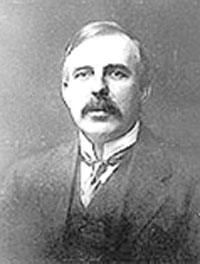May, 1911: Rutherford and the Discovery of the Atomic Nucleus
 |
| Ernest Rutherford |
In 1909, Ernest Rutherford’s student reported some unexpected results from an experiment Rutherford had assigned him. Rutherford called this news the most incredible event of his life.
In the now well-known experiment, alpha particles were observed to scatter backwards from a gold foil. Rutherford’s explanation, which he published in May 1911, was that the scattering was caused by a hard, dense core at the center of the atom–the nucleus.
Ernest Rutherford was born in New Zealand, in 1871, one of 12 children. Growing up, he often helped out on the family farm, but he was a good student, and received a scholarship to attend the University of New Zealand. After college he won a scholarship in 1894 to become a research student at Cambridge. Upon receiving the news of this scholarship, Rutherford is reported to have said, “That’s the last potato I’ll ever dig.”
At Cambridge, the young Rutherford worked in the Cavendish lab with J.J. Thomson, discoverer of the electron. Rutherford’s talent was quickly recognized, and in 1898 he took a professorship at McGill University in Montreal. There, he identified alpha and beta radiation as two separate types of radiation, and studied some of their properties, though he didn’t know that alphas were helium nuclei. In 1901 Rutherford and chemist Frederick Soddy found that one radioactive element can decay into another. The discovery earned Rutherford the 1908 Nobel Prize in Chemistry, which irritated him somewhat because he considered himself a physicist, not a chemist. (Rutherford is widely quoted as having said, “All science is either physics or stamp collecting”)
In 1907 Rutherford returned to England, to the University of Manchester. In 1909, he and his colleague Hans Geiger were looking for a research project for a student, Ernest Marsden. Rutherford had already been studying the scattering of alpha particles off a gold target, carefully measuring the small forward angles through which most of the particles scattered. Rutherford, who didn’t want to neglect any angle of an experiment, no matter how unpromising, suggested Marsden look to see if any alpha particles actually scattered backwards.
Marsden was not expected to find anything, but nonetheless he dutifully and carefully carried out the experiment. He later wrote that he felt it was a sort of test of his experimental skills. The experiment involved firing alpha particles from a radioactive source at a thin gold foil. Any scattered particles would hit a screen coated with zinc sulfide, which scintillates when hit with charged particles. Marsden was to sit in the darkened room, wait for his eyes to adjust to the darkness, and then patiently stare at the screen, expecting to see nothing at all.
Instead, Marsden saw lots of tiny, fleeting flashes of yellowish light, on average more than one blip per second.
He could hardly believe what he saw. He tested and retested every aspect of the experiment, but when he couldn’t find anything wrong, he reported the results to Rutherford.
Rutherford too was astonished. As he was fond of saying, “It was as if you fired a 15-inch shell at a piece of tissue paper and it came back and hit you."
About one in every few thousand of the alpha particles fired at the gold target had scattered at an angle greater than 90 degrees. This didn’t fit with the prevailing model of the atom, the so-called plum pudding model developed by J.J. Thomson. In this model electrons were believed to be stuck throughout a blob of positively charged matter, like raisins in a pudding. But this sort of arrangement would only cause small angle scattering, nothing like what Marsden had observed.
After thinking about the problem for over a year, Rutherford came up with an answer. The only explanation, Rutherford suggested in 1911, was that the alpha particles were being scattered by a large amount of positive charge concentrated in a very small space at the center of the gold atom. The electrons in the atom must be orbiting around this central core, like planets around the sun, Rutherford proposed.
Rutherford carried out a fairly simple calculation to find the size of the nucleus, and found it to be only about 1/100,000 the size of the atom. The atom was mostly empty space.
In March 1911, Rutherford announced his surprising finding at a meeting of the Manchester Literary and Philosophical Society, and in May 1911, he published a paper on the results in the Philosophical Magazine.
Later Rutherford and Marsden tried the experiment with other elements as the target, and measured their nuclei as well.
The solar system model was not immediately accepted. One obvious problem was that according to Maxwell’s equations, electrons traveling in a circular orbit should radiate energy, and therefore slow down and fall into the nucleus. A solar system atom wouldn’t last long.
Fortunately, Niels Bohr was soon able to save the solar system model by applying new ideas from quantum mechanics. He showed that the atom could stay intact if electrons were only allowed to occupy certain discrete orbitals.
Though Rutherford still didn’t know what was in this nucleus he had discovered (protons and neutrons would be identified later), his insight in 1911, which overturned the prevailing plum pudding model of the atom, had opened the way for modern nuclear physics.
©1995 - 2024, AMERICAN PHYSICAL SOCIETY
APS encourages the redistribution of the materials included in this newspaper provided that attribution to the source is noted and the materials are not truncated or changed.
Associate Editor: Jennifer Ouellette
Staff Writer: Ernie Tretkoff
May 2006 (Volume 15, Number 5)
Articles in this Issue

